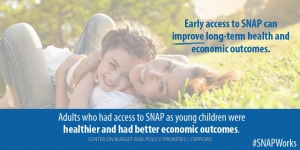Poverty
New Report Finds that #SNAPworks for Kids
A new report by the Center on Budget and Policy Priorities finds that the Supplemental Nutrition Assistance Program (SNAP) spends just $1.35 on average per person per meal for households with children, yet lifts millions of families and their children out of poverty. Here are some other key findings of the report:
- SNAP kept about 10.3 million people out of poverty in 2012, including about 4.9 million children.
- SNAP helps families put food on the table. Food insecurity — limited access to enough food for an active, healthy life — among children falls by roughly a third after their families receive SNAP benefits for six months.
- Some evidence suggests that children receiving SNAP are less likely than low-income non-participants to be in fair or poor health or underweight, and their families are less likely to trade off paying for health care and paying for other basic needs, like food, housing, heating, and electricity.
- Children who receive SNAP do better in school. SNAP participation can lead to improvements in reading and mathematics skills among elementary children, especially young girls, and increase the chances of graduating from high school.
- Adults who had access to SNAP as young children reported better health and had lower rates of “metabolic syndrome” (a combined measure of the incidence of obesity, high blood pressure, heart disease, and diabetes), and women who had access to food stamps as young children reported improved economic self-sufficiency (as measured by a combination of employment, income, poverty status, high school graduation, and program participation).
For more information, see the complete report:
SNAP Works for America’s Children
For 30 years now, Voices for Utah Children has called on our state, federal and local leaders to put children’s needs first. But the work is not done. The children of 30 years ago now have children of their own. Too many of these children are growing up in poverty, without access to healthcare or quality educational opportunities.
How can you be involved?
Make a tax-deductible donation to Voices for Utah Children—or join our Network with a monthly donation of $20 or more. Network membership includes complimentary admission to Network events with food, socializing, and opportunity to meet child advocacy experts. And don't forget to join our listserv to stay informed!
We look forward to the future of Voices for Utah Children and we hope you will be a part of our next 30 years.
Special thanks to American Express, our "Making a Difference All Year Long" sponsor. 
Using Data to Make a Difference
In the work that we do, it is imperative that we use data to inform our decisions and help children and their families access the resources they need. But with so many different tools and resources, it can be hard to find trusted information. That’s where the Data Center comes in. The Annie E. Casey Foundation’s KIDS COUNT Data Center contains thousands of child well-being indicators related to education, poverty, health and youth risk factors. By being able to filter by state, city, county and congressional district, users are able to access data that is relevant in their communities. Visit the Data Center today to enact change.
Here are some examples of the data tools you can find at the Kids Count Data Center.
Visit the Kids Count Data Center to find data you can share and embed on your own website!
For 30 years now, Voices for Utah Children has called on our state, federal and local leaders to put children’s needs first. But the work is not done. The children of 30 years ago now have children of their own. Too many of these children are growing up in poverty, without access to healthcare or quality educational opportunities.
How can you be involved?
Make a tax-deductible donation to Voices for Utah Children—or join our Network with a monthly donation of $20 or more. Network membership includes complimentary admission to Network events with food, socializing, and opportunity to meet child advocacy experts. And don't forget to join our listserv to stay informed!
We look forward to the future of Voices for Utah Children and we hope you will be a part of our next 30 years.
Special thanks to American Express, our "Making a Difference All Year Long" sponsor. 
Utah Spends Less Now per Pupil on K-12 Education than in 2008
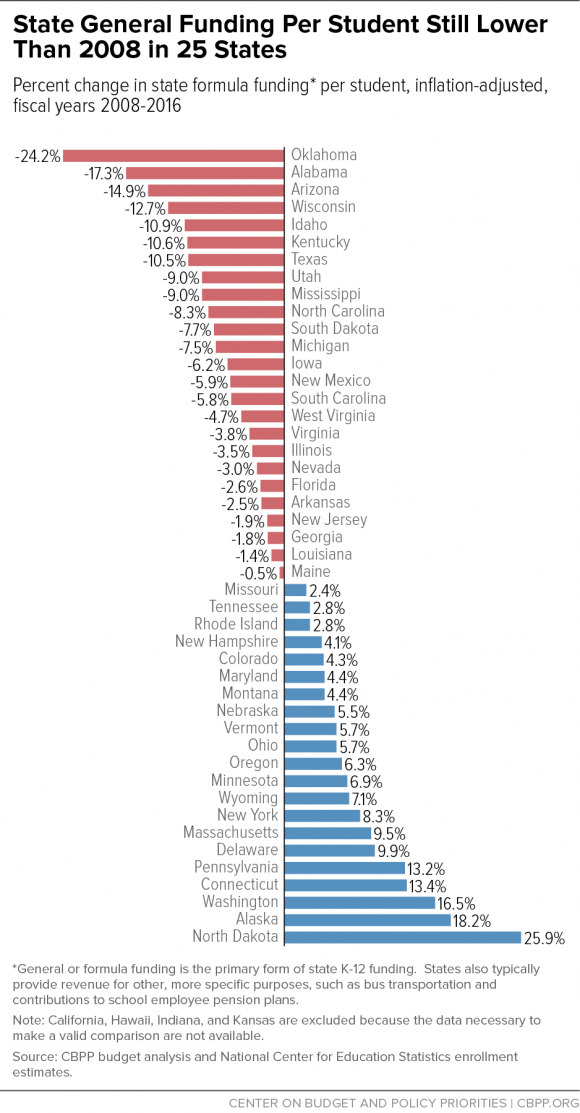 Most states, including Utah, provide less per-pupil funding for K-12 education now than they did before the 2008-2009 recession, according to a report titled, “Most States Have Cut School Funding, and Some Continue Cutting” by the Center on Budget and Policy Priorities. Their findings echo those reported by Voices for Utah Children in the Utah Children’s Budget Report.
Most states, including Utah, provide less per-pupil funding for K-12 education now than they did before the 2008-2009 recession, according to a report titled, “Most States Have Cut School Funding, and Some Continue Cutting” by the Center on Budget and Policy Priorities. Their findings echo those reported by Voices for Utah Children in the Utah Children’s Budget Report.
After the recession, property values dropped, making it hard for local school districts to raise significant revenue through local property taxes, but there was an “even steeper fall in state funding.” Meanwhile, the child population continued to grow.
The most recent data, for the 2016 school year, show that 25 states are offering less per-pupil general formula funding that in 2008. (General formula funding is the primary state funding source for schools.) In Utah, general formula funding per student has dropped by 9% since 2008. Only seven other states had a bigger drop in general formula funding than Utah.
But can’t we just do more with less? The authors point out that the data suggest otherwise:
“As common sense would suggest, money matters for educational outcomes. For instance, poor children who attend better-funded schools are more likely to complete high school and have higher earnings and lower poverty rates in adulthood.”
For 30 years now, Voices for Utah Children has called on our state, federal and local leaders to put children’s needs first. But the work is not done. The children of 30 years ago now have children of their own. Too many of these children are growing up in poverty, without access to healthcare or quality educational opportunities.
How can you be involved?
Make a tax-deductible donation to Voices for Utah Children—or join our Network with a monthly donation of $20 or more. Network membership includes complimentary admission to Network events with food, socializing, and opportunity to meet child advocacy experts. And don't forget to join our listserv to stay informed!
We look forward to the future of Voices for Utah Children and we hope you will be a part of our next 30 years.
Special thanks to American Express, our "Making a Difference All Year Long" sponsor. 
How the EITC is Helping Utah Families Succeed
The Secret of Utah’s Success
The secret of Utah’s success has long been our strong, hardworking families. For many of these families, the secret of their success has been the financial boost they get when they file their taxes, thanks to the Earned Income Tax Credit (EITC).
 The EITC was created under President Gerald R. Ford in 1975 as a way to support low-wage workers and their children. Its success in promoting work, independence, and family self-sufficiency has made it a bipartisan favorite. In 1986, the EITC was expanded by President Ronald Reagan as part of his historic Tax Reform Act, and every president since has improved and expanded it further. The results have been remarkable. In-depth studies have documented the EITC’s effects on both parents and children:
The EITC was created under President Gerald R. Ford in 1975 as a way to support low-wage workers and their children. Its success in promoting work, independence, and family self-sufficiency has made it a bipartisan favorite. In 1986, the EITC was expanded by President Ronald Reagan as part of his historic Tax Reform Act, and every president since has improved and expanded it further. The results have been remarkable. In-depth studies have documented the EITC’s effects on both parents and children:
- increased employment and earnings
- reduced welfare dependency
- improved maternal and child health
- enhanced school performance, including high school graduation and college matriculation rates
The EITC’s success in helping families succeed has led 26 states to create their own versions of the EITC, and that number grows every year. State EITC legislation passed the Utah House of Representatives in 2013 and 2014, indicating how seriously Utah legislators are considering this proposal.
This booklet shares the stories of hardworking Utah families whose lives have been transformed by the EITC. About 200,000 Utah families receive the EITC every year, nearly 20% of all filers. These families include about 300,000 children. As you read their stories, imagine how many more families will see their lives improve and their children’s prospects expand once Utah creates our own state version of the Earned Income Tax Credit.
Sharing Their Stories
EITC Facts for Utah
 The federal Earned Income Tax Credit was created under President Ford and expanded by Presidents Reagan, Bush, and all subsequent presidents.
The federal Earned Income Tax Credit was created under President Ford and expanded by Presidents Reagan, Bush, and all subsequent presidents.
- 204,000 Utah households received the federal EITC during 2015 for Tax Year 2014, about one in five tax filers.
- Utah’s EITC households include about 200,000 workers and 300,000 children.
- The EITC brought about $471 million into Utah’s economy in 2014.
- Thousands of veterans and military families are helped, at a higher rate than the general population.
- Were it not for the EITC, 67,000 more Utahns would have fallen into poverty in 2014, including 35,000 children. This would have raised Utah’s overall poverty rate by about 2.4 percentage points—about a one-quarter increase. For children, the increase would have amounted to 3.9 percentage points or a 40% increase in child poverty.
View the Complete Printer-Friendly Report:
![]() Sharing Their Stories: How the EITC is Helping Utah Families Succeed
Sharing Their Stories: How the EITC is Helping Utah Families Succeed
For 30 years now, Voices for Utah Children has called on our state, federal and local leaders to put children’s needs first. But the work is not done. The children of 30 years ago now have children of their own. Too many of these children are growing up in poverty, without access to healthcare or quality educational opportunities.
How can you be involved?
Make a tax-deductible donation to Voices for Utah Children—or join our Network with a monthly donation of $20 or more. Network membership includes complimentary admission to Network events with food, socializing, and opportunity to meet child advocacy experts. And don't forget to join our listserv to stay informed!
We look forward to the future of Voices for Utah Children and we hope you will be a part of our next 30 years.
Special thanks to American Express, our "Making a Difference All Year Long" sponsor. 
Greater Salt Lake City Equity Profile: A Closer Look at Racial & Ethnic Disparities
What does it mean to live in an equitable place? States and regions are considered equitable when all residents—regardless of their race, ethnicity, nativity, neighborhood of residence, or other characteristics—are fully able to participate in their community’s economic vitality, contribute to its readiness for the future, and connect to its assets and resources.
Utah is undergoing a profound demographic transformation in which people of color are a rapidly growing minority. Already more than quarter of Utah’s children are of color; in the Greater Salt Lake area, people of color represented only 8.4 percent of the total population in 1980, compared to 25.1 percent in 2010.
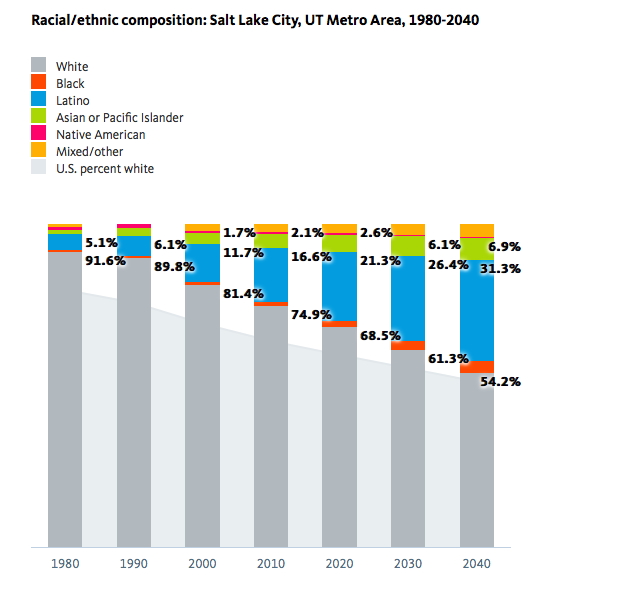
Between 2000 and 2010, the Black population in Greater Salt Lake had the highest growth rate—just over 67 percent—whereas the Native American population had the lowest, at -0.6 percent.

Our growing, diverse population has the potential to be a tremendous asset to our economy. But rising income inequality and persistent racial gaps in health, wealth, income, employment, education, and opportunity can prevent low-income people and people of color from participating fully in both our local and state economies. In the Salt Lake Metro, income for full-time workers at the 10th percentile has fallen by nearly 16 percent since 1979, while income for those at the 90th percentile risen by almost 4 percent.
This rising inequality disproportionately affects workers of color, who are concentrated in low-wage jobs that provide few opportunities for economic security or upward mobility. Workers of color consistently earn lower wages and are more likely to be jobless compared to their white counterparts, and racial gaps remain even among workers with similar education levels. In 2012, the median wage for workers of color in the Greater Salt Lake area was $7 less than the median wage for white workers.
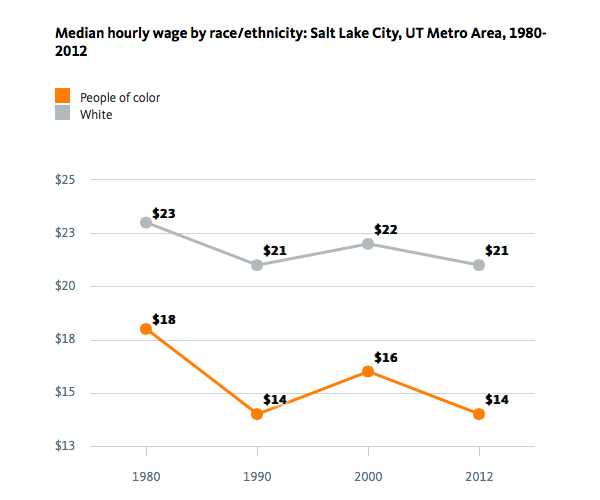
Racial economic inclusion is good for families, good for communities, and good for the economy. In the Salt Lake Metro, GDP would have been close to $7.8 billion higher in 2012 if people of color had earned the same as their white counterparts. This means fewer families would have lived in poverty, and there would have been significantly more in tax revenue.
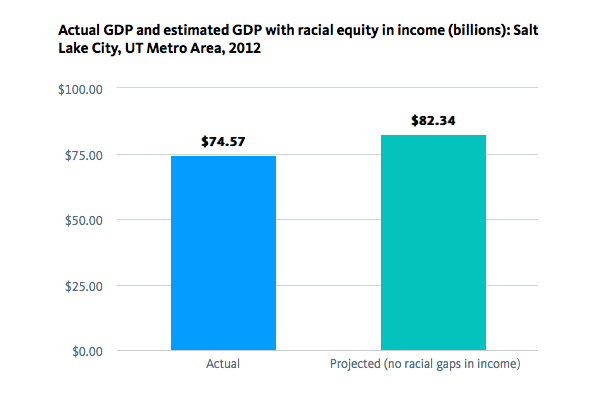
Economists, business leaders, and elected officials increasingly recognize that inequality is hindering economic growth, and that racial and economic inclusion are the drivers of a robust economy. To continue building a strong economy, both in Greater Salt Lake City and in Utah, leaders in the private and public sector need to advance an equitable growth agenda: a strategy to create good jobs, increase human capabilities, and expand opportunities for everyone to participate and prosper. Equity will make Utah stronger.
Printer-friendly Report:![]() Greater Salt Lake City Equity Profile: A Closer Look at Racial & Ethnic Disparities
Greater Salt Lake City Equity Profile: A Closer Look at Racial & Ethnic Disparities
For 30 years now, Voices for Utah Children has called on our state, federal and local leaders to put children’s needs first. But the work is not done. The children of 30 years ago now have children of their own. Too many of these children are growing up in poverty, without access to healthcare or quality educational opportunities.
How can you be involved?
Make a tax-deductible donation to Voices for Utah Children—or join our Network with a monthly donation of $20 or more. Network membership includes complimentary admission to Network events with food, socializing, and opportunity to meet child advocacy experts. And don't forget to join our listserv to stay informed!
We look forward to the future of Voices for Utah Children and we hope you will be a part of our next 30 years.
Special thanks to American Express for sponsoring our 30th Anniversary Year. 
Strategies to Address High Drug Prices
 Consumer representatives to the National Association of Insurance Commissioners, including Voices for Utah Children, released recommendations for policymakers to address the high prices that put medications out of reach for many families in need.
Consumer representatives to the National Association of Insurance Commissioners, including Voices for Utah Children, released recommendations for policymakers to address the high prices that put medications out of reach for many families in need.
Recommendations include:
- Limit the number of drug tiers that insurers can use;
- Limit consumer cost-sharing by, for instance, prohibiting coinsurance for prescription drugs;
- Adopt standardized plans with meaningful cost-sharing limits to mitigate adverse tiering;
- Prohibit mid-year formulary changes that negatively affect enrollee access to drugs;
- Require formularies to be updated weekly and include information about drug tiering, the actual dollar amount of any cost-sharing, any utilization management or network restrictions, and the process to request a drug exception, among other information;
- Collect standardized, plan-level data to enable the development of consumer tools and apps; and
- Solicit feedback from external stakeholders—such as advocates, other state agencies, ombudsmen, and independent medical experts—to inform the formulary review process.
For more information, see the complete report:
For 30 years now, Voices for Utah Children has called on our state, federal and local leaders to put children’s needs first. But the work is not done. The children of 30 years ago now have children of their own. Too many of these children are growing up in poverty, without access to healthcare or quality educational opportunities.
How can you be involved?
Make a tax-deductible donation to Voices for Utah Children—or join our Network with a monthly donation of $20 or more. Network membership includes complimentary admission to Network events with food, socializing, and opportunity to meet child advocacy experts. And don't forget to join our listserv to stay informed!
We look forward to the future of Voices for Utah Children and we hope you will be a part of our next 30 years.
Special thanks to American Express for sponsoring our 30th Anniversary Year. 
Utah has something to celebrate this #WomensEqualityDay
Happy Women's Equality Day! The Nineteenth Amendment, granting women the right to vote, was certified on August 26, 1920. Each year, we commemorate this important milestone and evaluate our progress toward achieving full equality for American women.
Here in Utah, a big part of that goal is reducing our gender gap in wages, which is one of the highest in the nation. Voices for Utah Children described the wage gap problem in the report Utah’s Gender Opportunity: An examination of the difference between the earnings of Utah men and women.
Addressing workplace policies that have a disparate impact on women  by making it more difficult to balance work with family responsibilities is key to eliminating the gender gap.
by making it more difficult to balance work with family responsibilities is key to eliminating the gender gap.
Fortunately, Utah made some progress in that direction during the past year. The Utah Legislature passed Senate Bill 59, which requires employers to provide reasonable accommodations for pregnant and breastfeeding women. The new law bumped Utah up from a failing grade to a C- in the National Partnership for Women & Families most recent rankings. Let's keep working our way up to an 'A'!
For 30 years now, Voices for Utah Children has called on our state, federal and local leaders to put children’s needs first. But the work is not done. The children of 30 years ago now have children of their own. Too many of these children are growing up in poverty, without access to healthcare or quality educational opportunities.
How can you be involved?
Make a tax-deductible donation to Voices for Utah Children—or join our Network with a monthly donation of $20 or more. Network membership includes complimentary admission to Network events with food, socializing, and opportunity to meet child advocacy experts. And don't forget to join our listserv to stay informed!
We look forward to the future of Voices for Utah Children and we hope you will be a part of our next 30 years.
Special thanks to American Express for sponsoring our 30th Anniversary Year. 
How does Utah stack up against Colorado?
This op-ed by Voices for Utah Children State Priorities Partnership Director Matthew Weinstein first appeared in the Salt Lake Tribune on June 18, 2016.
It is often said that Utah and Colorado are peer states, a pair of high-altitude economic powerhouses competing to attract the same growth-minded businesses and mobile workers in search of the best quality of life. What lessons can we learn from Colorado, and what can they learn from us?
The two states have many economic similarities — rapid growth, young populations, high household incomes, low poverty and unemployment rates, strong business climate rankings. But where do the similarities end? And which is better poised for stronger growth going forward? Our children's futures depend on being able to answer these questions and learn lessons from peer states like Colorado.
Earlier this month, Voices for Utah Children released the first half of our two-part comparison of Utah and Colorado, comparing the two states for 21 measures of economic opportunity. The results shed light on these questions and include a lot of good news for Utah, as well as some caution signs — and at least one "red alert" warning.
Utah ranks among the very best states in the nation for our low level of income inequality and high rate of intergenerational social mobility. A child growing up in a lower-income family in Utah has a better chance than elsewhere of making it into the middle class. This is thanks to a combination of factors, including our strong commitment to equalizing educational revenue among the wealthier and poorer areas of the state, our success at preventing geographic concentration of poverty, the highest rate of two-parent families in the nation, and our strong charitable and religious institutions that do such a great job of mobilizing volunteers to help neighbors in need.
While Colorado ranks more in the middle of the pack for income inequality and social mobility, our neighbor to the east shines when it comes to educational attainment, with one of the highest rates of bachelor's degrees in the nation. In 2014, 39.4 percent of Colorado adults age 25-64 had a bachelor's degree, nearly 8 points above the national average of 31.5 percent. For historical perspective, in 1990 Colorado's lead over the nation for bachelor's degrees was only 6.5 percentage points.
By this very important metric, unfortunately, Utah's trend is in the opposite direction. In 1990 we led the nation by 1.3 percentage points for bachelor's degrees. But our lead has been steadily diminishing since then, and in 2014, for the first time on record, Utah fell behind the nation for bachelor's degrees among adults age 25-64. Moreover, data for millennials — adults age 25-34 — indicate that this trend will only worsen in the years to come.
This is the red alert warning mentioned above. Falling behind on college degrees could have grave consequences for Utah's ability to grow good jobs and compete for high-wage industries in the years to come. We already lag far behind Colorado in worker productivity — by nearly $10,000 per worker — which is the economic basis for wages and standard of living.
If there is one glimmer of hope for Utah in the college comparison, it's that, even after all the budget cuts and tuition hikes of the last decade, we continue to invest more than Colorado in our public universities — $7,752 per student vs. $4,754. That helps keep tuition 35 percent lower in Utah than next door, though at $6,363 on average, it is still 37 percent higher than before the Great Recession.
But the investment edge that Utah enjoys in higher ed vanishes at the early end of public education. Not only do we invest less per pupil in K-12 than any other state, including Colorado, we are weakest when it comes to pre-K and kindergarten. Only 13 percent of our 4-year-olds attend public pre-school vs. three times that in Colorado. And a similar share attend full-day kindergarten here vs. 74 percent in Colorado.
And while we find good news in the 4th and 8th grade NAEP math and reading assessments, where Utah's performance jumped sharply to 14th place in 2015 from 23rd in 2013, we remain far behind when we adjust the scores for demographic differences. Our demographically-adjusted NAEP ranking only improved from 47th place to 44th, while Colorado fell from 12th to 22nd.
As Utah builds on our many assets and grapples with our challenges in the years to come, we believe this benchmarking information can contribute to understanding why we are succeeding and how we can ensure our continued success in the years and generations to come.
Read the complete reports here:
A Comparative Look at Utah and Colorado:
For 30 years now, Voices for Utah Children has called on our state, federal and local leaders to put children’s needs first. But the work is not done. The children of 30 years ago now have children of their own. Too many of these children are growing up in poverty, without access to healthcare or quality educational opportunities.
How can you be involved?
Make a tax-deductible donation to Voices for Utah Children—or join our Network with a monthly donation of $20 or more. Network membership includes complimentary admission to Network events with food, socializing, and opportunity to meet child advocacy experts. And don't forget to join our listserv to stay informed!
We look forward to the future of Voices for Utah Children and we hope you will be a part of our next 30 years.
Special thanks to American Express for sponsoring our 30th Anniversary Year. 
Helping Candidates Do Their Homework
2016 Candidate Briefing Guide
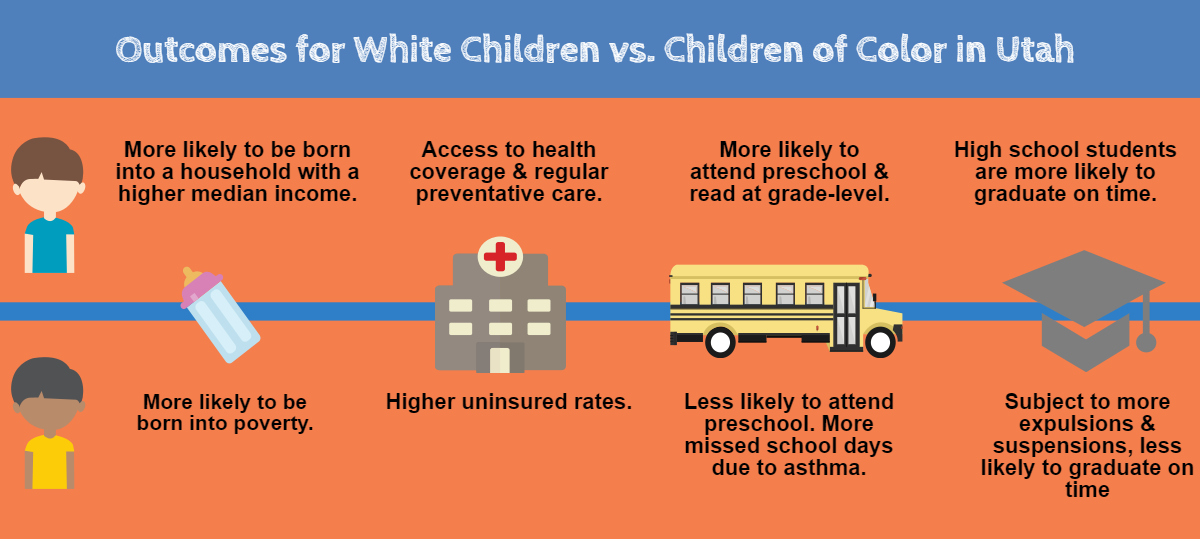
2016 is an important election year in Utah. The public offices on the ballot in November include the following:
- U.S. Senate
- U.S. House of Representatives
- Governor and Lt. Governor
- Half of the State Senate
- The entire Utah House of Representatives
Our elected officials play a central role in determining whether all children have the opportunity for health, safety, education, and economic security. As the Utah child population grows and becomes more diverse, it is important for candidates to discuss the needs of Utah children and the policies they would pursue to ensure that all Utah's children can thrive.
Voices for Utah Children is providing candidates for elected office in Utah with the resources in this Candidate Briefing Guide to help them understand the challenges facing Utah's children, direct public awareness and dialogue toward the needs of children over the course of their campaigns, and begin their terms of office prepared to enact effective policies to protect their youngest constituents.
Utah voters can also use these resources to educate ourselves about children’s issues as we seek to elect candidates that will prioritize the needs of children and invest in our state’s future.
More Information:
Racial and Ethnic Equity for Children in Utah: What we learned from the 2016 Legislative Session
Economic Security/Tax & Budget
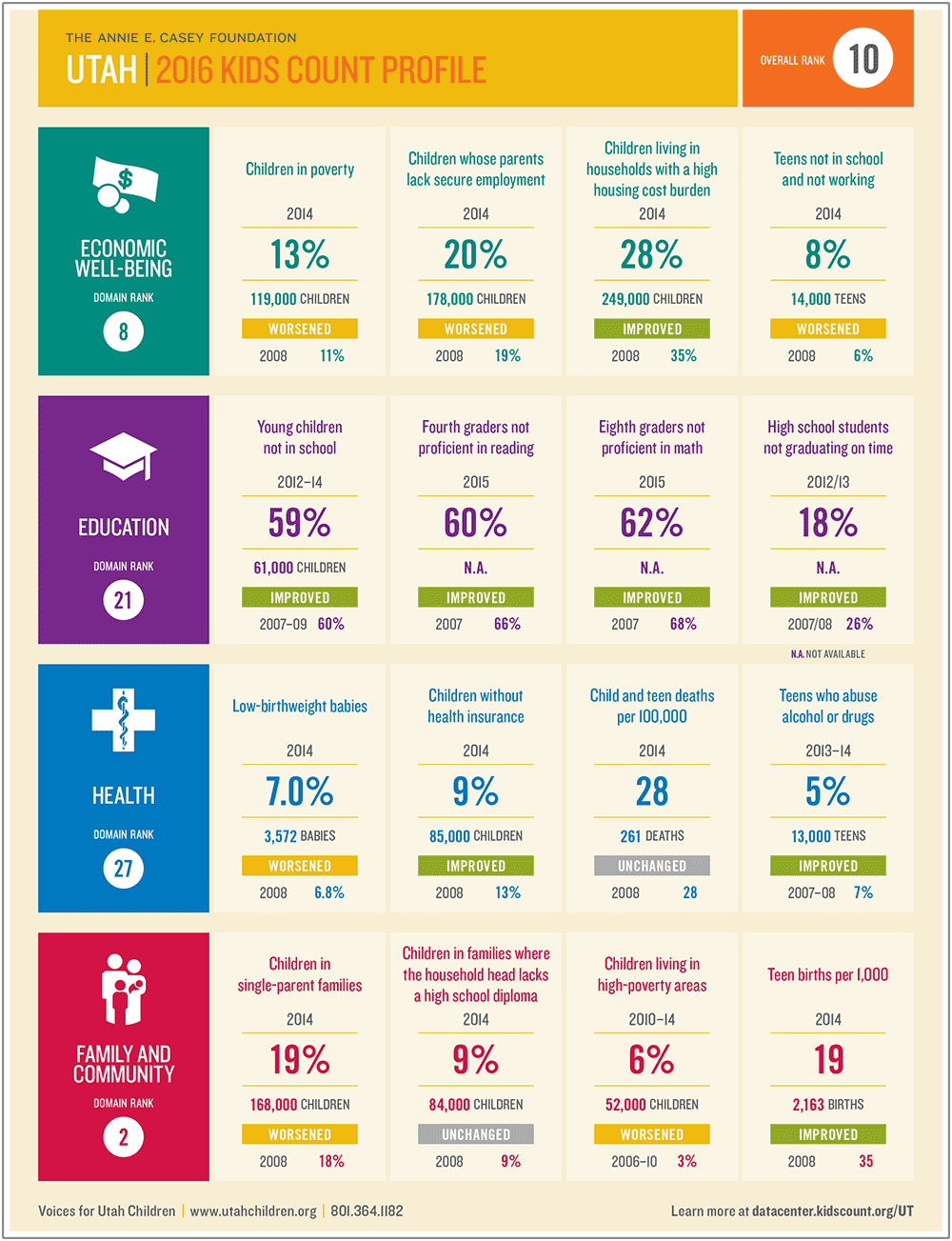 Supported by the Annie E. Casey Foundation, our KIDS COUNT® work aims to provide Utah’s legislators, public officials and child advocates with reliable data, policy recommendations and other tools needed to advance the kinds of sound policies that benefit children and families across the state.
Supported by the Annie E. Casey Foundation, our KIDS COUNT® work aims to provide Utah’s legislators, public officials and child advocates with reliable data, policy recommendations and other tools needed to advance the kinds of sound policies that benefit children and families across the state.
This year, Utah barely held on to its position among the top ten in the annual Annie E. Casey Foundation KIDS COUNT® Data Book report. Ranking 9th in 2015, Utah now ranks 10th among the fifty states (despite a dramatic change in the health domain, where Utah dropped from 7th in 2015 to 27th in 2016). Utah’s 2nd place ranking for the Family & Community domain and 8th place ranking for Economic Well-Being remained unchanged. In the Education domain, Utah ranked 21st — up from 29th in 2015.
Terry Haven 
Deputy Director
Voices for Utah Children
More Information:
Measures of Well-Being in Utah, 2015
![]() 2016 Utah and United States Kids Count Profiles
2016 Utah and United States Kids Count Profiles
The Federal Safety Net Cuts Child Poverty in Utah in Half
Each child brings the promise of a healthier, stronger future for Utah. To make good on that promise, Utah needs to make sure children can grow up healthy, from the prenatal period all the way through their teenage years.
Utah children and families should have access to:
- Appropriate prenatal care;
- Affordable, accessible, culturally competent care that encompasses both prevention and treatment; and
- Supportive services and environments designed to help facilitate the best possible health outcomes.
All families in Utah must be able to achieve optimal health in order for our state to continue to grow and prosper.
Jessie Mandle, MPH 
Health Policy Analyst
Voices for Utah Children
More Information:
12-Month Continuous Eligibility for Children on Medicaid
Utah's Uninsured Rate for Hispanic Children: Highest in the Country
A Coverage Gap Solution for Utah Families
Majority of Eligible Parents Who Would Benefit from Medicaid Expansion are Working
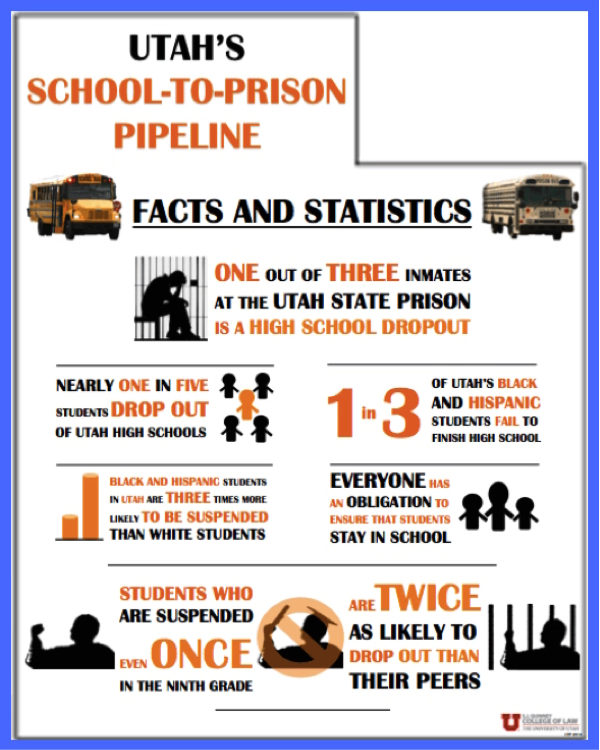 Voices for Utah Children seeks to reduce juvenile incarceration rates and eliminate the inappropriate use of secure confinement and out-of-home placement, ensuring that juvenile correction systems better protect youth and the public.
Voices for Utah Children seeks to reduce juvenile incarceration rates and eliminate the inappropriate use of secure confinement and out-of-home placement, ensuring that juvenile correction systems better protect youth and the public.
A key aspect of our juvenile justice work involves a commitment to challenging the School-to-Prison Pipeline, wherein children — particularly children of color and those with disabilities — are funneled out of public schools and into juvenile and criminal justice systems in a discriminatory application of discipline. “Zero-tolerance” policies criminalize minor infractions in the classroom, while the presence of law enforcement officers in schools often leads to student behavior being criminalized rather than handled within the school setting.
We are committed to the belief that children should be educated, not incarcerated. We work to empower advocates and community members alike, arming people with information that allows them take action to end School-to-Prison Pipeline.
Lincoln M. Nehring, JD 
President & CEO
Voices for Utah Children
The early years in a child’s life form the core foundation for later social, emotional and cognitive development. Done well, early childhood education can help level the playing field, especially for low-income children, by closing the access and achievement gaps, thereby enhancing not only school performance, but self-sufficiency over a lifetime.
At Voices for Utah Children, we focus on promoting targeted investments in early childhood education, with the goal of creating a statewide early learning system in Utah that supports all families by making sure they have access to high-quality options for their children’s early care and learning—whether children spend their days at home, in formal child care, or with family and friends.
Tess Davis, JD 
Policy Analyst
Voices for Utah Children
More Information:
Optional Extended-Day Kindergarten
5 Minute Guide to Shared Services
Economic Security/Tax & Budget
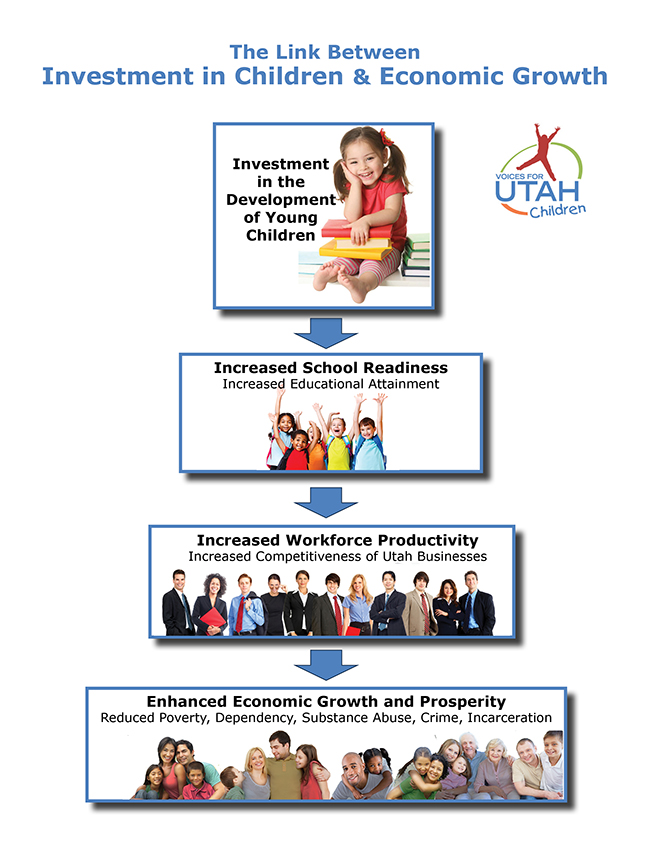
Every day, state governments raise and spend tax revenue in ways that profoundly affect families and communities. The fiscal choices Utah makes — about investing in schools, health care, child care, and other services — can help foster equal opportunity and lay the foundations for our future growth and prosperity.
Voices for Utah Children's fiscal policy program works to ensure that we invest sufficient resources in the vital public systems that ensure that our kids get world-class education and health care as well as special support for children most in need. We also work to ensure that public revenues are generated in ways that are fair; no family should be taxed into poverty as the price of educating their children.
Matthew Weinstein, MPP 
State Priorities Partnership Director
Voices for Utah Children
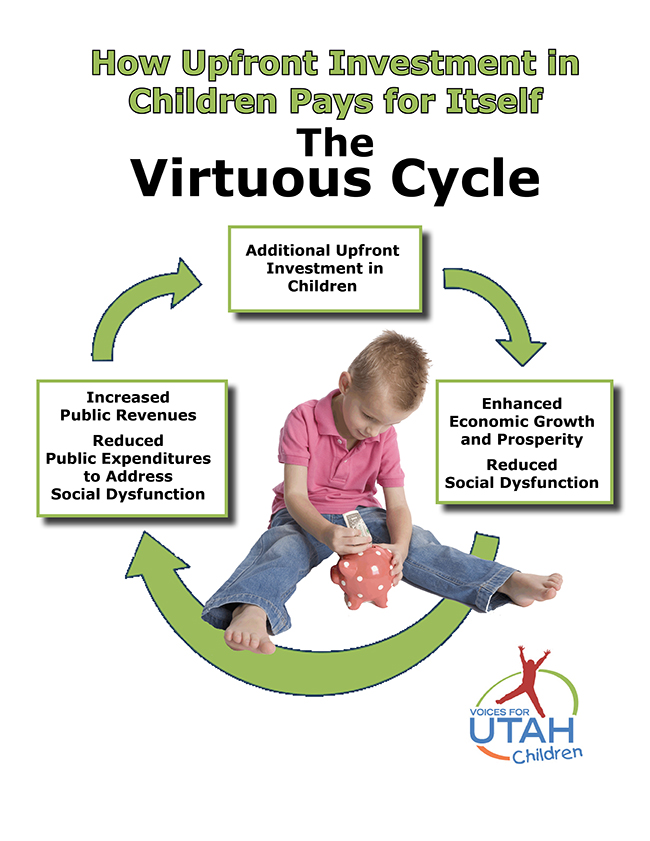
More Information:
Utah Children's Budget Report 2015
What's Still Eating Utah's General Fund?
Top 10 Reasons to End the Earmarks
Deseret News: Social service advocates call for lawmakers to 'end the earmarks'
Utah Policy.com: Poll: Utahns Split on Eliminating Transportation Earmarks
A Comparative Look at Utah and Colorado:
Part 1: Economic Opportunity
Part 2: Standard of Living
The Earned Income Tax Credit: A Time-Tested Two-Generation Strategy for Poverty
For 30 years now, Voices for Utah Children has called on our state, federal and local leaders to put children’s needs first. But the work is not done. The children of 30 years ago now have children of their own. Too many of these children are growing up in poverty, without access to healthcare or quality educational opportunities.
How can you be involved?
Make a tax-deductible donation to Voices for Utah Children—or join our Network with a monthly donation of $20 or more. Network membership includes complimentary admission to Network events with food, socializing, and opportunity to meet child advocacy experts. And don't forget to join our listserv to stay informed!
We look forward to the future of Voices for Utah Children and we hope you will be a part of our next 30 years.
Special thanks to American Express for sponsoring our 30th Anniversary Year. 
The wait is over!
Spread the word: lawfully residing immigrant kids can enroll in CHIP and Medicaid now!
As of July 1st, 2016, new legislation takes effect that eliminates the previously mandated 5-year waiting period before lawfully-residing immigrant children in Utah could enroll in CHIP and Medicaid. Thank you to the Utah Legislature and the Utah Department of Health for making this change! Five years is too long for a child to wait. More good news: the federal government will match up to 100% of the state dollars Utah spends to remove the 5-year waiting period, making this a fiscally-prudent policy change for Utah.
Voices for Utah children supported ending the 5-year wait during the 2016 Utah Legislative Session. Utah has the highest rate of uninsured Hispanic children in the nation and the removal of the 5-year wait is a significant step to help all children in Utah access affordable health coverage.
In addition to allowing states to end the 5-year wait for children, the 2009 Children’s Health Insurance Program Reauthorization Act (CHIPRA) gives states the option to expand insurance coverage to lawfully residing pregnant women. Utah has not yet accepted that option. Going forward, let's end the 5-year wait for pregnant women, too! Prenatal care improves the health of both mothers and their children.
To learn more about CHIP and Medicaid eligibility, call 211 or visit takecareutah.org. (A Spanish version is available at takecareutah.org/es/.)
For 30 years now, Voices for Utah Children has called on our state, federal and local leaders to put children’s needs first. But the work is not done. The children of 30 years ago now have children of their own. Too many of these children are growing up in poverty, without access to healthcare or quality educational opportunities.
How can you be involved?
Make a tax-deductible donation to Voices for Utah Children—or join our Network with a monthly donation of $20 or more. Network membership includes complimentary admission to Network events with food, socializing, and opportunity to meet child advocacy experts. And don't forget to join our listserv to stay informed!
We look forward to the future of Voices for Utah Children and we hope you will be a part of our next 30 years.
Special thanks to American Express for sponsoring our 30th Anniversary Year. 

